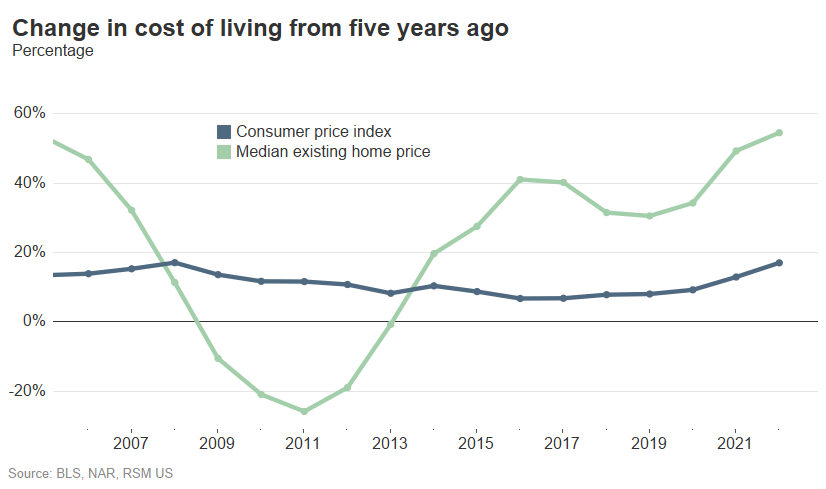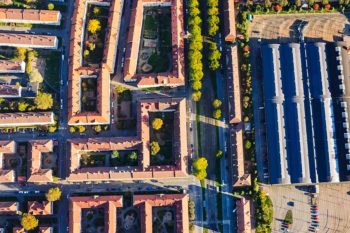Insights
The American housing deficit and what it takes to close it
REAL ECONOMY BLOG | June 22, 2022
Authored by RSM US LLP
Over the past 15 years, the United States has not built enough houses to keep up with growing demand. The problem intensified during the pandemic as demand skyrocketed because of the shift to working from home and historically low mortgage rates encouraged this move.
At the end of last year, the U.S. was about 3.5 million homes short of the number required to maintain a stable market.
We estimate that at the end of last year, the U.S. was about 3.5 million homes short of the number required to maintain a stable market.
Together with the rising cost of building materials, the depleted supply of new homes has pushed housing prices to record highs, contributing to a rate of inflation not seen in more than 40 years.
To close the gap, the U.S. housing market will need 1.7 million new houses on average each year until 2030, according to our estimates. This figure is calculated based on current economic conditions, cost of living and a long-term growth forecast of 1.8% annually.
Given that there were only 1.6 million new housing starts last year when the market was booming, it would be impossible to rely on the private sector to deliver such a high level of new houses each year, especially as the market for housing has cooled sharply.
We believe that government agencies at the national and local level need to take a more active role to overcome the current housing deficit, adopting policies including more flexible zoning restrictions, expanded housing tax credits and regulations that broaden affordability.

Forecasting housing demand
The collapse of the housing market during the financial crisis not only slowed down demand for new homes but it also made builders wary about being too aggressive. Sentiment among builders plunged so far that it did not recover until 2017.
From 2007 to 2020, new housing starts—a proxy for new housing supply—never crossed the 1.5 million mark, which was widely estimated to be the average annual supply needed to meet target household demand in the 2010s.
This resulted in a growing housing deficit that reached 3.8 million units through the end of 2020, according to a recent report from Freddie Mac, which we used as the benchmark level of housing shortages to then recalculate the existing deficit in 2021.
The long-term supply to meet new household demand through 2030 in our base case is 1.3 million units each year. This includes 900,000 units for newly formed households annually, which is consistent with the five-year average level of net household formations from 2016 to 2021, according to data from the Current Population Survey of the Census Bureau.

The estimate for new household formations is also in line with Freddie Mac’s lower bound forecast for housing demand in the 2016-2025 period. The lower bound was derived based on the assumption that the cost of living for households in 2025 would be 20% higher than what they had experienced before 2016 as higher living costs have been found to discourage household formations.
The assumption is not far off as the five-year changes in the consumer price index reached 13% last year and 17% in the first half of this year. We expect inflation to remain persistent in the second half of the year, especially regarding housing costs, which also hamper new households to be formed.
The other 400,000 units account for second home demand, existing home replacements and a healthy stock of vacant units, required to stabilize the market.

The housing boom during the pandemic years has helped to incentivize builders to provide more new homes driven by steep rises in demand and prices. There were 1.6 million new housing starts recorded last year by the Census Bureau. That total included an extra 300,000 new housing units last year, pushing the total deficit by the end of last year to 3.5 million units.
To completely close such a deficit and at the same time meet the new annual demand of 1.3 million new homes, the U.S. will need about 1.7 million units each year until 2030.

That said, our estimate would be subjected to downside risks from rising inflation, which reduces Americans’ desire to form new households. There is also the risk of an economic slowdown or even an outright recession as the Federal Reserve aggressively raises interest rates to tame inflation.
In the past two business cycles, net household formations dropped significantly during the recession years, falling to fewer than 1 million from 2007 to 2010, and even dropping to negative territory in 2020. Demand for new homes and creating new households often decline during recessions as personal incomes drop while spending falls substantially.
But even with an economic slowdown or potential recession in the coming months, construction of new homes will need to increase to close the existing gap. The deteriorating builder sentiment as a result of rapidly rising mortgage rates, which hit 5.65% as of June 17, and continued headwinds from labor and supply chain challenges are poised to limit new construction, further extending the housing shortage.
Closing the housing gap
The shortfall is in many respects an outgrowth of the financial crisis over a decade ago. The long-lasting impact of that crisis will not be fixed overnight and will require a sustained and balanced approach that results in an increase in housing supply. Two measures can help address the shortfall:
- Fix the zoning rules: First and foremost, zoning that limits construction needs to be relaxed and redesigned to reflect the changing demographics of demand that characterizes the American economy.
- Expand affordability: Second, low-income housing tax credits and neighborhood home tax credits that support construction and redevelopment of local homes will need to be put in place through federal and state financing so that the affordability crisis can be addressed.
Regulatory barriers around local and state economies will need to be reduced and the affordability crisis faced by Gen Z and Millennial cohorts needs to be immediately addressed. Both are necessary to promote generational economic equity and to relieve a housing shortage that is now contributing to overall inflation.
The takeaway
Providing enough affordable houses for all Americans will have a significant impact on the economy: Not only would it address rising housing costs but it would provide shelter that is unattainable for many Americans.
But the private market can’t do it on its own. Only by redesigning local and federal government policies, which incentivize more supply while keeping prices down, will the market provide the 1.7 million homes a year needed to meet the growing demand of a rising generation.
Let's Talk!
Call us at +1 213.873.1700, email us at solutions@vasquezcpa.com or fill out the form below and we'll contact you to discuss your specific situation.
This article was written by Joseph Brusuelas, Nick Grandy, Tuan Nguyen, Crystal Sunbury and originally appeared on .
2022 RSM US LLP. All rights reserved.
https://realeconomy.rsmus.com/the-american-housing-deficit-and-what-it-takes-to-overcome-the-issue/
RSM US Alliance provides its members with access to resources of RSM US LLP. RSM US Alliance member firms are separate and independent businesses and legal entities that are responsible for their own acts and omissions, and each is separate and independent from RSM US LLP. RSM US LLP is the U.S. member firm of RSM International, a global network of independent audit, tax, and consulting firms. Members of RSM US Alliance have access to RSM International resources through RSM US LLP but are not member firms of RSM International. Visit rsmus.com/about us for more information regarding RSM US LLP and RSM International. The RSM logo is used under license by RSM US LLP. RSM US Alliance products and services are proprietary to RSM US LLP.

Vasquez & Company LLP is a proud member of the RSM US Alliance, a premier affiliation of independent accounting and consulting firms in the United States. RSM US Alliance provides our firm with access to resources of RSM US LLP, the leading provider of audit, tax and consulting services focused on the middle market. RSM US LLP is a licensed CPA firm and the U.S. member of RSM International, a global network of independent audit, tax and consulting firms with more than 43,000 people in over 120 countries.
Our membership in RSM US Alliance has elevated our capabilities in the marketplace, helping to differentiate our firm from the competition while allowing us to maintain our independence and entrepreneurial culture. We have access to a valuable peer network of like-sized firms as well as a broad range of tools, expertise and technical resources.
For more information on how Vasquez & Company LLP can assist you, please call +1 213.873.1700.
Subscribe to receive important updates from our Insights and Resources.
